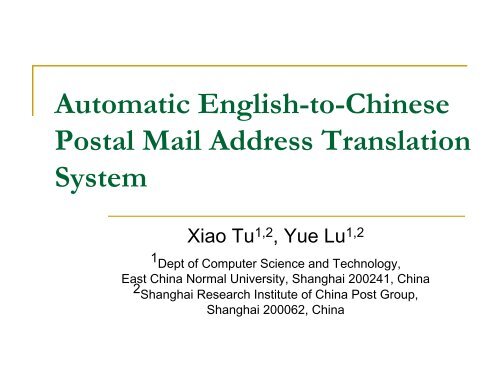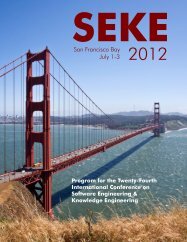Automatic English-to-Chinese Postal Mail Address Translation System
Automatic English-to-Chinese Postal Mail Address Translation System
Automatic English-to-Chinese Postal Mail Address Translation System
You also want an ePaper? Increase the reach of your titles
YUMPU automatically turns print PDFs into web optimized ePapers that Google loves.
<strong>Au<strong>to</strong>matic</strong> <strong>English</strong>-<strong>to</strong>-<strong>Chinese</strong><br />
<strong>Postal</strong> <strong>Mail</strong> <strong>Address</strong> <strong>Translation</strong><br />
<strong>System</strong><br />
Xiao Tu 1,2 , Yue Lu 1,2<br />
1 Dept of Computer Science and Technology,<br />
East China Normal University, Shanghai 200241, China<br />
2 Shanghai Research Institute of China Post Group,<br />
Shanghai 200062, China
Background<br />
Objective: <strong>to</strong> translation <strong>English</strong>-written address on<br />
an envelope <strong>to</strong> its corresponding <strong>Chinese</strong><br />
Input: scanned image<br />
Output: translated address text<br />
Image of <strong>Postal</strong> <strong>Mail</strong><br />
<strong>English</strong>-written <strong>Address</strong><br />
of the <strong>Postal</strong> <strong>Mail</strong><br />
Copyright Reserved
<strong>System</strong> Overview<br />
<strong>Mail</strong> Feeder<br />
Localization, Segmentation &<br />
Recognition of Destination<br />
<strong>Address</strong><br />
Image<br />
Acquisition<br />
<strong>Chinese</strong><br />
<strong>Address</strong><br />
Printing<br />
Localization<br />
of Printing<br />
<strong>English</strong> <strong>to</strong> <strong>Chinese</strong><br />
<strong>Address</strong> <strong>Translation</strong><br />
<strong>Mail</strong><br />
Sorting<br />
<strong>Mail</strong> Stack<br />
Decoding<br />
<strong>Address</strong><br />
Database<br />
<strong>Address</strong> <strong>Translation</strong> Unit<br />
<strong>Au<strong>to</strong>matic</strong> <strong>English</strong>-<strong>to</strong>-<strong>Chinese</strong> <strong>Postal</strong> <strong>Mail</strong> <strong>Address</strong> <strong>Translation</strong> <strong>System</strong><br />
Copyright Reserved
Challenges<br />
The following is OCR results of the post mail<br />
Professor Yue Lu<br />
Chair, Department of<br />
Computer<br />
Science and Technology<br />
East Chma NormaI University<br />
500 Dongehuan Road<br />
Shanghai 200241, CHINA<br />
in<br />
I<br />
c<br />
m<br />
I<br />
e<br />
The errors are unavoidable in any OCR system<br />
Solution: using the inexact word matching technology<br />
Copyright Reserved
Challenges<br />
<strong>Chinese</strong> address may be expressed in different ways in<br />
<strong>English</strong> and sometimes mixed with homonymic <strong>Chinese</strong><br />
Pinyin<br />
<strong>Chinese</strong> <strong>Address</strong>: 中 山 北 路 392 弄 32 号 703 室<br />
<strong>English</strong>-written:<br />
•Room 703, No 32, Lane 392, North zhongshan Road<br />
•703 shi 32 hao 392 nong Zhong Shan Bei Lu<br />
•Unit 703 32# Long 392 Zhongshan Road (N)<br />
No specific language rules are available<br />
Solution: create specific language rules for address<br />
understanding<br />
Copyright Reserved
<strong>Address</strong> Understanding<br />
Based on the inexact word matching technology and the<br />
rules, an unstructured address text gotten from the OCR<br />
system is converted <strong>to</strong> structured address information<br />
items.<br />
<strong>Address</strong> Information Item is a POSTCODE, a CITY, a<br />
DISTRICT, a ROAD, a ZONE, a BUILDING,<br />
NUMBERS, a COMPANY, or ADDRESSEES and so on.<br />
Make use of ‘keyword’s like such as ‘Road’, ‘Room’,<br />
‘Building’ and ‘University’ in an address.
<strong>Address</strong> Understanding<br />
POS Tagging and Disambiguation<br />
CityKeyword(CK)<br />
DistrictKeyword(DK)<br />
RoadKeyword(RK)<br />
BuildingKeyword (BK)<br />
CompanyKeyword<br />
(CPK)<br />
FloorKeyword (FK)<br />
Number (NB)<br />
LetterString (LS)<br />
POS Tagset<br />
CityName(CN)<br />
DistrictName (DN)<br />
OrientalKeyword(OL)<br />
ZoneKeyword (ZK)<br />
TitleKeyword (TK)<br />
Postcode (PC)<br />
Punctuation (PN)<br />
NoKeyword (NK)<br />
Copyright Reserved
<strong>Address</strong> Understanding<br />
POS Tagging and Disambiguation<br />
Lexicon:<br />
LexmeNo< POS>.<br />
• is a parameter used <strong>to</strong> verify whether a<br />
word is the same as the in a lexeme.<br />
• lists ’s all possible parts of speech.<br />
• provides disambiguation rules <strong>to</strong> identify a word’s<br />
POS in context.<br />
1. Use the inexact word matching method <strong>to</strong> calculate the current<br />
word with all s in Lexicon.<br />
2. Choose the most similar one’s <strong>to</strong> judge<br />
whether the current word is the one.<br />
3. If yes, using the corresponding Disambiguation rule<br />
<strong>to</strong> decide the word’s pos.<br />
4. Those words that are not covered in the lexicon are<br />
‘LetterString’.
Inexact word matching method<br />
For a string A of length m and a string B of length n, V(i, j) is defined as the similarity<br />
value of the prefixes[a 1 ,a 2 ,…,a i ] and [b 1 ,b 2 ,…,b j ]. The similarity of A and B is precisely<br />
the value V(m,n). The similarity of two strings A and B can be computed by dynamic<br />
programming with recurrence.<br />
The base conditions are:<br />
V(i,j) = 0, 0 ≤<br />
⎧V(i<br />
− 1, j − 1) + σ ( a , b<br />
⎪<br />
V(i, j) = max⎨V(i<br />
− 1, j)<br />
⎪<br />
⎩<br />
V(i, j − 1)<br />
i<br />
≤<br />
i j)<br />
m, 0<br />
The general recurrence relation is: For 1 ≤ i ≤ m,<br />
≤<br />
j<br />
1<br />
≤<br />
≤<br />
n<br />
j ≤<br />
Here, the matching score between the two letters a i and b j is defined as<br />
σ ( a , b<br />
i<br />
j<br />
⎪⎧<br />
2<br />
) = ⎨<br />
⎪⎩ − 2<br />
a<br />
a<br />
i<br />
i<br />
=<br />
≠<br />
b<br />
b<br />
j<br />
j<br />
n<br />
Copyright Reserved
Inexact word matching method<br />
We define the similarity between A and B as<br />
~<br />
V<br />
V m n<br />
Sim ( A,<br />
B)<br />
=<br />
( ~ , )<br />
= m×<br />
σ ( a , a ) = m is the similarity between A and itself.<br />
A i i<br />
2<br />
V A<br />
If Sim(A, B)≥θ , B matches A, or B is equal <strong>to</strong> A.<br />
θ is a predefined threshold.<br />
Copyright Reserved
<strong>Address</strong> Understanding<br />
Disambiguation<br />
In the disambiguation rules, a word’s POS depends on the POSs of<br />
both its previous word and post word .<br />
We represent the rule as<br />
….<br />
•[Conditionx] is a subset of the tagset, denoted by POS1| POS2|…|<br />
POSk (a “|” is a logic or).<br />
•If the previous word’s POS is in the [Conditionx] and the post word’s<br />
POS is in the [Conditionx’], the current word is POS_x.<br />
•If not, consider the couple of conditions in the next pair of angle<br />
brackets.<br />
•If all the couples of conditions fail, then the current word is POS_0.<br />
Copyright Reserved
<strong>Address</strong> Understanding<br />
<strong>Address</strong> Information Items<br />
An unstructured address text is converted <strong>to</strong> nine address<br />
information items by Deterministic Finite Au<strong>to</strong>mata (DFA) .<br />
No<br />
2 4<br />
A ROAD consists of three parts, viz.<br />
a prefix, a road keyword and a suffix.<br />
RK<br />
NB<br />
0<br />
OL<br />
RK<br />
LS<br />
LS<br />
LS<br />
LS<br />
1<br />
LS OL<br />
3<br />
6<br />
DFA1 for the Prefix (Reverse)<br />
OL<br />
0 1<br />
(b) DFA2 for the Suffix<br />
OL<br />
5<br />
LS<br />
Take ‘Room 301 No 329 Nan Jing<br />
Road West Shanghai 200031 China’<br />
as an example of a OCRed address.<br />
‘Road’ is a RK (road keyword), ‘Jing<br />
Nan 329 No 301 Room’ is S 1<br />
in<br />
reserve order, and ‘West shanghai<br />
200031 China’ is S 2<br />
. DFA1 accepted<br />
‘Jing Nan’ as the longest<br />
subsequence and DFA2 accepted<br />
‘West’ as the longest one. Hence, a<br />
‘Road’ is ‘Nan Jing Road West’.<br />
Copyright Reserved
<strong>Address</strong> <strong>Translation</strong><br />
• AddrX (Sec 1 , Sec 2 , … , Sec 9 ) denotes the address understanding<br />
result of an address, where Sec j (1≤ j≤ 9) denotes a postcode, a<br />
city name, a district name, a road name, a zone name, a building<br />
name, numbers, a company name and addressee names,<br />
respectively.<br />
• DB k (Item 1 , Item 2 ,…, Item 9 , CItem 1 , CItem 2 , … , CItem 9 ) denotes a<br />
record in the database, where 1≤ k ≤ N (N is the <strong>to</strong>tal of the<br />
records in the database). Item j , (1≤ j≤ 9) denotes a postcode, a<br />
city name, a district name, a road name, a zone name, a building<br />
name, numbers, a company name and addressee names,<br />
respectively. And CItem j (1≤ j≤ 9) is the translation text of Item j .<br />
Copyright Reserved
<strong>Address</strong> <strong>Translation</strong><br />
The similarity value between AddrX and DB k is defined as<br />
Let<br />
λ<br />
ϕ ( AddrX , DB<br />
k<br />
ϕ =<br />
i<br />
ϕ ≥λ<br />
k<br />
) =<br />
9<br />
∑<br />
j=<br />
1<br />
Max ϕ ( AddrsX<br />
1≤k<br />
≤ N<br />
k<br />
Sim( Sec<br />
, DB<br />
k<br />
m<br />
)<br />
j<br />
,<br />
Item<br />
If i<br />
, AddrX matches DB i<br />
and DB i<br />
(CItem 1<br />
, CItem 2<br />
, …, CItem 9<br />
)<br />
is the translation result of AddrX.<br />
denotes a predefined address matching threshold.<br />
j<br />
)<br />
,<br />
Copyright Reserved
<strong>System</strong> Implementation<br />
We implemented the presented system with C++ on Windows 2000.<br />
The experiments with the proposed method were carried on 10,000<br />
real envelop images. We respectively selected 1.00, 0.95, 0.90, 0.85<br />
and 0.80 as the value of the address matching threshold .<br />
100.0%<br />
80.0%<br />
60.0%<br />
40.0%<br />
20.0%<br />
0.0%<br />
λ<br />
60.1%<br />
39.8%<br />
71.6%<br />
28.2%<br />
78.2%<br />
21.4%<br />
82.1%<br />
17.3%<br />
0.0% 0.2% 0.4% 0.6%<br />
1.00 0.95 0.90 0.85 0.80<br />
85.4%<br />
13.3%<br />
1.3%<br />
TraRate<br />
RejRate<br />
ErrRate<br />
The experiment results showed that 0.80 is the best one<br />
with high translation rate and low error rate.<br />
λ<br />
Copyright Reserved
<strong>System</strong> Implementation<br />
Items AddrX DB i<br />
Similarity<br />
value<br />
POSTCODE 200241 200241 1.0000<br />
CITY Shanghai Shanghai 1.0000<br />
ROAD Dongehuan Road Dongchuan Road 0.8571<br />
NUMBERS 500 500 1.0000<br />
UNIVERSITY<br />
DEPARTMENT<br />
East Chma<br />
NormaI University<br />
Department<br />
of Computer Science and<br />
Technology<br />
East China<br />
Normal University<br />
Department<br />
of Computer Science<br />
and Technology<br />
0.8036<br />
1.0000<br />
ADDRESSEE Professor Yue Lu Professor Yue Lu 1.0000<br />
The similarity is<br />
ϕ = 0.9515<br />
i<br />
≥ λ<br />
, so AddrX and DB i are matched.<br />
Copyright Reserved
<strong>System</strong> Implementation<br />
DB i ’s CItems<br />
CItems<br />
200241<br />
上 海<br />
东 川 路<br />
500<br />
华 东 师 范 大 学<br />
计 算 机 科 学 技 术 系<br />
吕 岳 教 授<br />
<strong>Translation</strong> result printed on the envelop<br />
Copyright Reserved
Conclusions<br />
• The present <strong>Au<strong>to</strong>matic</strong> <strong>English</strong>-<strong>to</strong>-<strong>Chinese</strong> <strong>Postal</strong> <strong>Mail</strong><br />
<strong>Address</strong> <strong>Translation</strong> <strong>System</strong> is a novel attempt in both<br />
machine translation and postal au<strong>to</strong>mation.<br />
• To solve the influence caused by OCR errors, we<br />
propose an address translation method based on the<br />
inexact word matching technology.<br />
• The experimental results have showed that the system<br />
has achieved a translation rate of 82% with a low error<br />
rate and proved the proposed method is effective and<br />
feasible. The system has been already put in<strong>to</strong><br />
application in Shanghai Post Office.<br />
• In further work, entropy and relationship of each address<br />
information item will be taken in<strong>to</strong> account <strong>to</strong> further<br />
improve the robustness of address understanding.<br />
Copyright Reserved
Thank you !<br />
Copyright Reserved
















